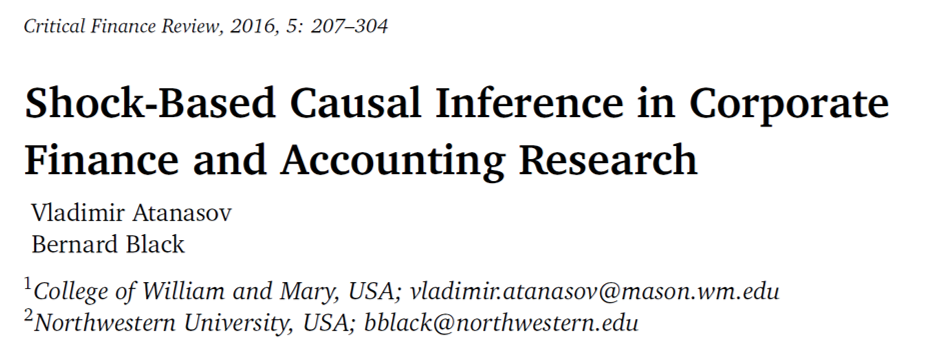Issues in Empirical Finance Research
2020-10-27
The challenge
- I will discuss some issues in using plain OLS models in Corporate Finance & Governance Research
- I will avoid the word “endogeneity” as much as I can
- I will also avoid the word “identification” because identification does not guarantee causality and vice-versa (Kahn and Whited 2017)
- The discussion is based on Atanasov and Black (2016)

The challenge
Imagine that you want to investigate the effect of Governance on Q
- You may have more covariates explaining Q (omitted from slides)
\(𝑸_{i} = α + 𝜷_{i} × Gov + Controls + error\)
All the issues in the next slides will make it not possible to infer that changing Gov will CAUSE a change in Q
That is, cannot infer causality

1) Reverse causation
One source of bias is: reverse causation
Perhaps it is Q that causes Gov
OLS based methods do not tell the difference between these two betas:
\(𝑄_{i} = α + 𝜷_{i} × Gov + Controls + error\)
\(Gov_{i} = α + 𝜷_{i} × Q + Controls + error\)
If one Beta is significant, the other will most likely be significant too
You need a sound theory!
2) Omitted variable bias (OVB)
The second source of bias is: OVB
Imagine that you do not include an important “true” predictor of Q
Let’s say, long is: \(𝑸_{i} = 𝜶_{long} + 𝜷_{long}* gov_{i} + δ * omitted + error\)
But you estimate short: \(𝑸_{i} = 𝜶_{short} + 𝜷_{short}* gov_{i} + error\)
\(𝜷_{short}\) will be:
\(𝜷_{short} = 𝜷_{long}\) + bias
\(𝜷_{short} = 𝜷_{long}\) + relationship between omitted (omitted) and included (Gov) * effect of omitted in long (δ)
- Where: relationship between omitted (omitted) and included (Gov) is: \(Omitted = 𝜶 + ϕ *gov_{i} + u\)
Thus, OVB is: \(𝜷_{short} – 𝜷_{long} = ϕ * δ\)
See an example in r here
3) Specification error
The third source of bias is: Specification error
Even if we could perfectly measure gov and all relevant covariates, we would not know for sure the functional form through which each influences q
- Functional form: linear? Quadratic? Log-log? Semi-log?
Misspecification of x’s is similar to OVB
4) Signaling
The fourth source of bias is: Signaling
Perhaps, some individuals are signaling the existence of an X without truly having it:
- For instance: firms signaling they have good governance without having it
This is similar to the OVB because you cannot observe the full story
5) Simultaneity
The fifth source of bias is: Simultaneity
Perhaps gov and some other variable x are determined simultaneously
Perhaps there is bidirectional causation, with q causing gov and gov also causing q
In both cases, OLS regression will provide a biased estimate of the effect
Also, the sign might be wrong
6) Heterogeneous effects
The sixth source of bias is: Heterogeneous effects
Maybe the causal effect of gov on q depends on observed and unobserved firm characteristics:
- Let’s assume that firms seek to maximize q
- Different firms have different optimal gov
- Firms know their optimal gov
- If we observed all factors that affect q, each firm would be at its own optimum and OLS regression would give a non-significant coefficient
In such case, we may find a positive or negative relationship.
Neither is the true causal relationship
7) Construct validity
The seventh source of bias is: Construct validity
Some constructs (e.g. Corporate governance) are complex, and sometimes have conflicting mechanisms
We usually don’t know for sure what “good” governance is, for instance
It is common that we use imperfect proxies
They may poorly fit the underlying concept
8) Measurement error
The eighth source of bias is: Measurement error
“Classical” random measurement error for the outcome will inflate standard errors but will not lead to biased coefficients.
- \(y^{*} = y + \sigma_{1}\)
- If you estimante \(y^{*} = f(x)\), you have \(y + \sigma_{1} = x + \epsilon\)
- \(y = x + u\)
- where \(u = \epsilon + \sigma_{1}\)
“Classical” random measurement error in x’s will bias coefficient estimates toward zero
- \(x^{*} = x + \sigma_{2}\)
- Imagine that \(x^{*}\) is a bunch of noise
- It would not explain anything
- Thus, your results are biased toward zero
9) Observation bias
The ninth source of bias is: Observation bias
This is analogous to the Hawthorne effect, in which observed subjects behave differently because they are observed
Firms which change gov may behave differently because their managers or employees think the change in gov matters, when in fact it has no direct effect
10) Interdependent effects
The tenth source of bias is: Interdependent effects
Imagine that a governance reform that will not affect share prices for a single firm might be effective if several firms adopt
Conversely, a reform that improves efficiency for a single firm might not improve profitability if adopted widely because the gains will be competed away
“One swallow doesn’t make a summer”
11) Selection bias
The eleventh source of bias is: Selection bias
If you run a regression with two types of companies
- High gov (let’s say they are the treated group)
- Low gov (let’s say they are the control group)
Without any matching method, these companies are likely not comparable
Thus, the estimated beta will contain selection bias
The bias can be either be positive or negative
It is similar to OVB
12) Self-Selection
The twelfth source of bias is: Self-Selection
Self-selection is a type of selection bias
Usually, firms decide which level of governance they adopt
There are reasons why firms adopt high governance
- If observable, you need to control for
- If unobservable, you have a problem
It is like they “self-select” into the treatment
- Units decide whether they receive the treatment of not
Your coefficients will be biased
THANK YOU!

